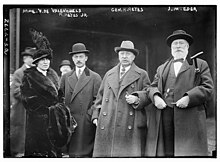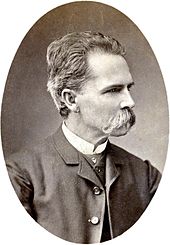| Total population | |
|---|---|
| 20%–35%[1][2][3][4] of the Colombian population | |
| Regions with significant populations | |
| Throughout the nation, especially in the Andean Region and the major cities[5] | |
| Languages | |
| Predominantly Colombian Spanish[citation needed] | |
| Religion | |
| Christianity (Roman Catholic)[citation needed] | |
| Related ethnic groups | |
| Europeans · West Asians Mestizo Colombians · White Latin Americans |
White Colombians (Spanish: Colombianos Blancos) are Colombians who have total or predominantly European or West Asian ancestry. According to the 2018 census, 87.58% of Colombians do not identify with any ethnic group, being either White or Mestizo (of mixed European and Amerindian ancestry), which are not categorized separately.[6]
Distribution and ethnic background
[edit]While most sources estimate Whites to be 20% of the country's population,[1][2][3] the Federal Research Division (using data from the 2005 census) puts that percentage at 37%.[4]
According to a Latinobarómetro poll, 26% of Colombians surveyed self-identified as White,[7][8]
White Colombians primarily live in the Andean Region and the urban centres.[9] Most are of Spanish origin, but there is also a large population of Middle Eastern descendants,[10] as well as some Italian,[11] German,[12] and other European ancestries.[13][14]
Genetics
[edit]Genetic ancestry of White Colombians according to Candela Project (2014).[15]
According to research published in 2014, which evaluated the Colombian genetic pool, the average Colombian genetic makeup is 65% European, 26% Amerindian, and 9% African, with self-identified white Colombians (19.3% of the samples) being 65% European, 26% Amerindian, and 9% African.[15]
History
[edit]Before the arrival of Europeans, Colombia was inhabited by various indigenous tribes.[16]
Colonial period
[edit]The presence of Whites in Colombia began in 1510 with the colonization of San Sebastián de Urabá. Many Spaniards came searching for gold, while others established themselves locally as leaders of Christian social organizations.[17]
Immigration from Europe
[edit]Basque priests introduced Handball into Colombia.[18] Along with business, Basque immigrants in Colombia were devoted to teaching and public administration.[18] In the first years of the Andean multinational company, Basque sailors navigated as captains and pilots on most of the ships until the country could train its own crews.[18] In Bogotá, there is a small colony of thirty to forty families who emigrated due to the Spanish Civil War.[19]
The first German immigrants arrived in the 16th century, contracted by the Spanish Crown, and included explorers such as Ambrosio Alfinger and Nikolaus Federmann. There was another small wave of German immigrants at the end of the 19th and beginning of the 20th century, including Leo Siegfried Kopp, the founder of the famous Bavaria Brewery. SCADTA, a Colombian-German air transport corporation established by German expatriates in 1919, was the first commercial airline in the Western Hemisphere.[20]


In December 1941, the United States government estimated that at least 4,000 Germans were living in Colombia.[21]
A wave of Ashkenazi immigrants came after the rise of Nazism in 1933, followed by as many as 17,000 German Jews. From 1939 until the end of World War II, immigration was forced to stop through anti-immigrant policies and restrictions on immigration from Germany.[22]
There were some Nazi agitators in Colombia, such as Barranquilla businessman Emil Prufurt,[21] but the majority were apolitical. Colombia asked Germans who were on the U.S. blacklist to leave and allowed German and Jewish refugees in the country illegally to stay.[21]
Immigration from the Middle East
[edit]Colombia was one of the early focal points of Sephardi immigration.[23] Jewish converts to Christianity and some crypto-Jews also sailed with the early explorers. It has been suggested that the present-day culture of business entrepreneurship in Antioquia and Valle del Cauca is attributable to Sephardi immigration.[24][better source needed]
The largest wave of Middle Eastern immigration began around 1880 and remained during the first two decades of the 20th century. They were mainly Maronite Christians from Lebanon, Syria and Ottoman Palestine, fleeing financial hardships and the repression of the Turkish Ottoman Empire. When they were first processed in the ports of Colombia, they were classified as Turks (in part because most of them had Ottoman Passports at the time).
During the early 20th century, numerous Jewish immigrants came from Turkey, North Africa, and Syria. Shortly after, Jewish immigrants began to arrive from Eastern Europe.[21] Armenians, Lebanese, Syrians,[25] Palestinians, and some Israelis[26] have continued to settle in Colombia.[25]
Between 700,000 and 3,200,000 Colombians have full or partial Middle Eastern descent.[27][28] Due to a lack of information, it is impossible to know the exact number of people who immigrated to Colombia. A figure of 50,000-100,000 from 1880 to 1930 may be reliable.[25] Regardless of the figure, the Lebanese are perhaps the biggest immigrant group, next to the Spanish, since independence.[25] Cartagena, Cali, and Bogota were among the cities with Colombia's largest number of Arabic-speaking representatives in 1945.[25]
See also
[edit]- Race and Ethnicity in Colombia
- Demographics of Colombia
- Colombians
- Mestizo Colombians
- Black Colombians
- Native Colombians
- Immigration to Colombia
- White people
- Romani people in Colombia
- Mennonites in Colombia
- History of the Jews in Colombia
Immigrant communities in Colombia
[edit]References
[edit]- ^ a b "Geografia Humana de Colombia" (PDF). p. 20.
- ^ a b "The World Fact Book".
- ^ a b Lizcano Fernández, Francisco (2005). "Composición Étnica de las Tres Áreas Culturales del Continente Americano al Comienzo del Siglo XXI" [Ethnic Composition of Three Cultural Areas of the Americas at the Beginning of the XXIst Century] (PDF). Convergencia (in Spanish). 38 (May–August): 185–232. ISSN 1405-1435. Archived from the original (PDF) on 20 September 2008. Retrieved 19 March 2023. See table on page 218.
- ^ a b library of congress. "Colombia a country study" (PDF). pdf. Retrieved 2 March 2022.
- ^ Bushnell & Hudson, p. 87-88.
- ^ "Geoportal del DANE - Geovisor CNPV 2018". geoportal.dane.gov.co. Retrieved 5 August 2021.
- ^ "Informe Latinobarómetro 2018". Latinobarometro. Retrieved 3 October 2022.
- ^ Simon Schwartzman. "Étnia, condiciones de vida y discriminación" (PDF). pdf. Retrieved 2 March 2022.
- ^ Bushnell & Hudson, p. 87-88.
- ^ "Apuntes sobre la inmigración sirio-libanesa en Colombia". www.nodo50.org. Retrieved 26 January 2022.
- ^ Vidal Ortega, Antonino; D’Amato Castillo, Giuseppe (1 December 2015). "Los otros, sin patria: italianos en el litoral Caribe de Colombia a comienzos del siglo XX". Caravelle. Cahiers du monde hispanique et luso-brésilien (in French) (105): 153–175. doi:10.4000/caravelle.1822. ISSN 1147-6753.
- ^ "Estos fueron los primeros alemanes en Colombia". Revista Diners | Revista Colombiana de Cultura y Estilo de Vida (in Spanish). 10 June 2019. Retrieved 26 January 2022.
- ^ "Conozca a los inmigrantes europeos que se quedaron en Colombia". Revista Diners | Revista Colombiana de Cultura y Estilo de Vida (in Spanish). 2 July 2020. Retrieved 26 January 2022.
- ^ "News & Events - Irlandeses en Colombia y Antioquia - Department of Foreign Affairs". www.dfa.ie. Retrieved 11 June 2022.
- ^ a b Ruiz-Linares, Andrés; Adhikari, Kaustubh; Acuña-Alonzo, Victor; Quinto-Sanchez, Mirsha; Jaramillo, Claudia; Arias, William; Fuentes, Macarena; Pizarro, María; Everardo, Paola; Avila, Francisco de; Gómez-Valdés, Jorge (25 September 2014). "Admixture in Latin America: Geographic Structure, Phenotypic Diversity and Self-Perception of Ancestry Based on 7,342 Individuals". PLOS Genetics. 10 (9): e1004572. doi:10.1371/journal.pgen.1004572. ISSN 1553-7404. PMC 4177621. PMID 25254375.
- ^ Invading Colombia.
- ^ Fodor's South America. p. 402.
- ^ a b c Possible paradises: Basque emigration to Latin America by José Manuel Azcona Pastor, P.203
- ^ Amerikanuak: Basques in the New World by William A. Douglass, Jon Bilbao, P.167
- ^ Jim Watson. "SCADTA Joins the Fight". Stampnotes.com. Archived from the original on 24 September 2015. Retrieved 20 February 2015.
- ^ a b c d Latin America during World War II by Thomas M. Leonard, John F. Bratzel, P.117
- ^ Ignacio Klich & Jeff Lesser, Arab and Jewish Immigrants in Latin America: Images and Realities, Psychology Press, 1997, pages 76-78
- ^ "'Lost Jews' Of Colombia Say They've Found Their Roots". NPR.org. Retrieved 25 November 2014.
- ^ Wasko, Dennis (13 June 2011). "The Jewish Palate: The Jews of Colombia - Arts & Culture - Jerusalem Post". Jpost.com. Retrieved 20 February 2015.
- ^ a b c d e de Posada, Louise Fawcett; Eduardo Posada-Carbó (1992). "En la tierra de las oportunidades: los sirio-libaneses en Colombia" [In the land of opportunity: the Syrian-Lebanese in Colombia]. Boletín Cultural y Bibliográfico (in Spanish). XXIX (29). Archived from the original on 3 August 2009. Retrieved 24 August 2010.
- ^ Fawcett, Louise; Posada‐Carbo, Eduardo (21 June 2010). "Arabs and Jews in the development of the Colombian Caribbean 1850–1950". Immigrants & Minorities. 16 (1–2): 57–79. doi:10.1080/02619288.1997.9974903.
- ^ "Agência de Notícias Brasil-Árabe". .anba.com.br. Archived from the original on 31 January 2016. Retrieved 20 February 2015.
- ^ S.A.S, Editorial La República. "Colombia y Medio Oriente". Diario La República (in Spanish). Retrieved 16 July 2022.
Works cited
[edit]- Bushnell, David and Rex A. Hudson. "Racial distinctions". In Colombia: A Country Study (Rex A. Hudson, ed.). Library of Congress Federal Research Division (2010).
 This article incorporates text from this source, which is in the public domain.
This article incorporates text from this source, which is in the public domain.